Permanent Makeup Removal: The Ultimate Guide
If you’re not satisfied with your PMU, don’t panic – permanent makeup removal is possible. Your options are laser, glycolic acid, and saline removal. Our guide answers all your questions on risks, cost, aftercare, and more.
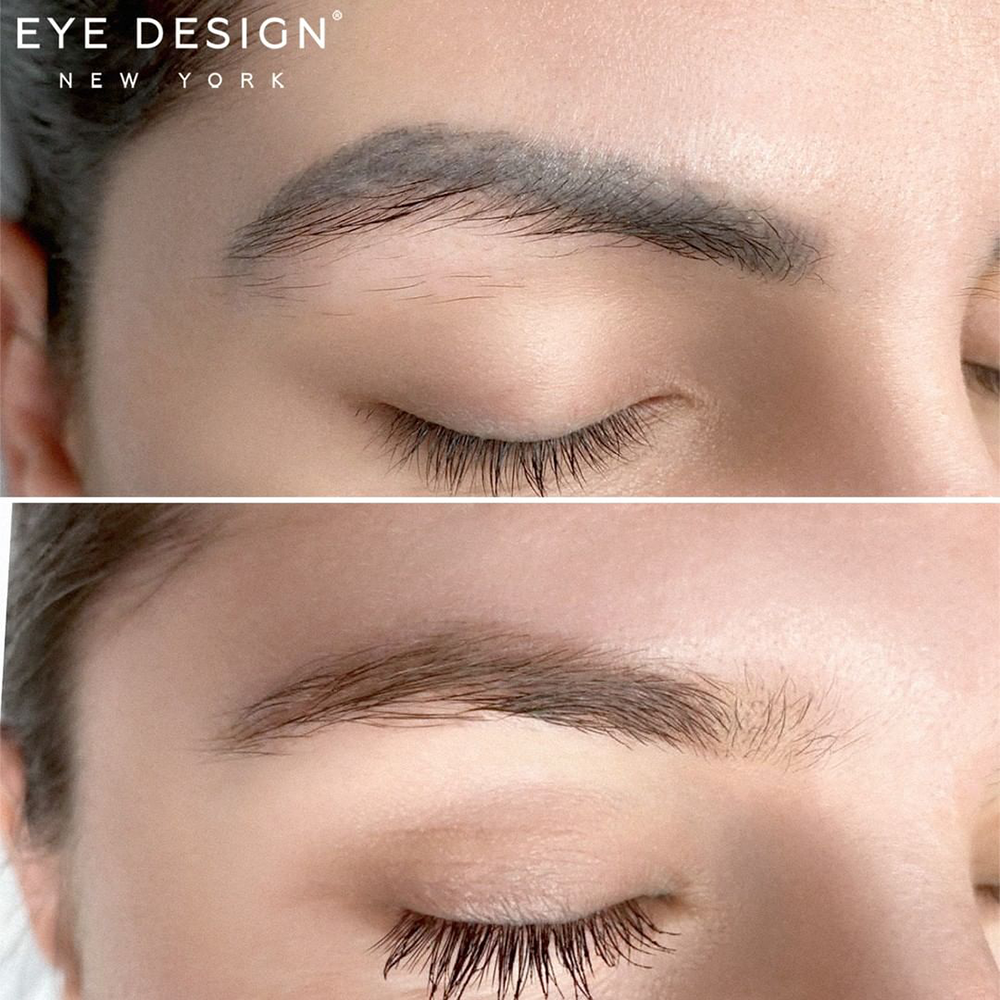
Image source : PMUhub
Explore more PMU removal topics:
Editor’s Note: This post was originally published in April 2019. Updated in September 2021.
Permanent makeup is a great way to enhance your look. It can recreate the look of wearing any style of makeup, camouflage minor scars, and correct any imperfections you may be insecure about.
The biggest benefit of PMU is definitely the fact that it doesn’t wash off and lasts for months or years, depending on the treatment. But when it doesn’t work out and you end up unsatisfied with the results, the blessing can become a curse.
Since cosmetic tattooing is only semi-permanent, it will fade away eventually. But sometimes, waiting it out is not an option. That’s why PMU professionals came up with ways to remove permanent makeup.
Here’s everything you need to know about permanent makeup removal.
ABOUT PERMANENT MAKEUP REMOVAL
Is Permanent Makeup Really Permanent?
Even though the name suggests that permanent makeup lasts forever, it actually doesn’t.
Cosmetic tattooing is done with PMU pigments, rather than traditional body art inks. These formulas are concocted in such a way that the body dissolves them over a period of several years, meaning that the effects eventually become invisible if they’re not touched up and refreshed.
Another factor that makes PMU only semi-permanent is the very shallow depth at which it’s injected. The pigments are deposited into the surface layers of the skin, and the natural cycle of cell turnover eventually fades them additionally.
The results of most PMU treatments last about 2 years, with the exception of scalp micropigmentation, which lasts longer.
Is Permanent Makeup Removal Possible?
Just like it’s the case with traditional tattoos, PMU removal is definitely possible, but it takes time.
There are 3 methods of permanent makeup removal that have been proven to work:
- Laser removal
- Saline removal
- Glycolic acid removal
All these require several sessions, with periods of skin recovery between them. So if you decide to get rid of your PMU, know that it will probably take several months.
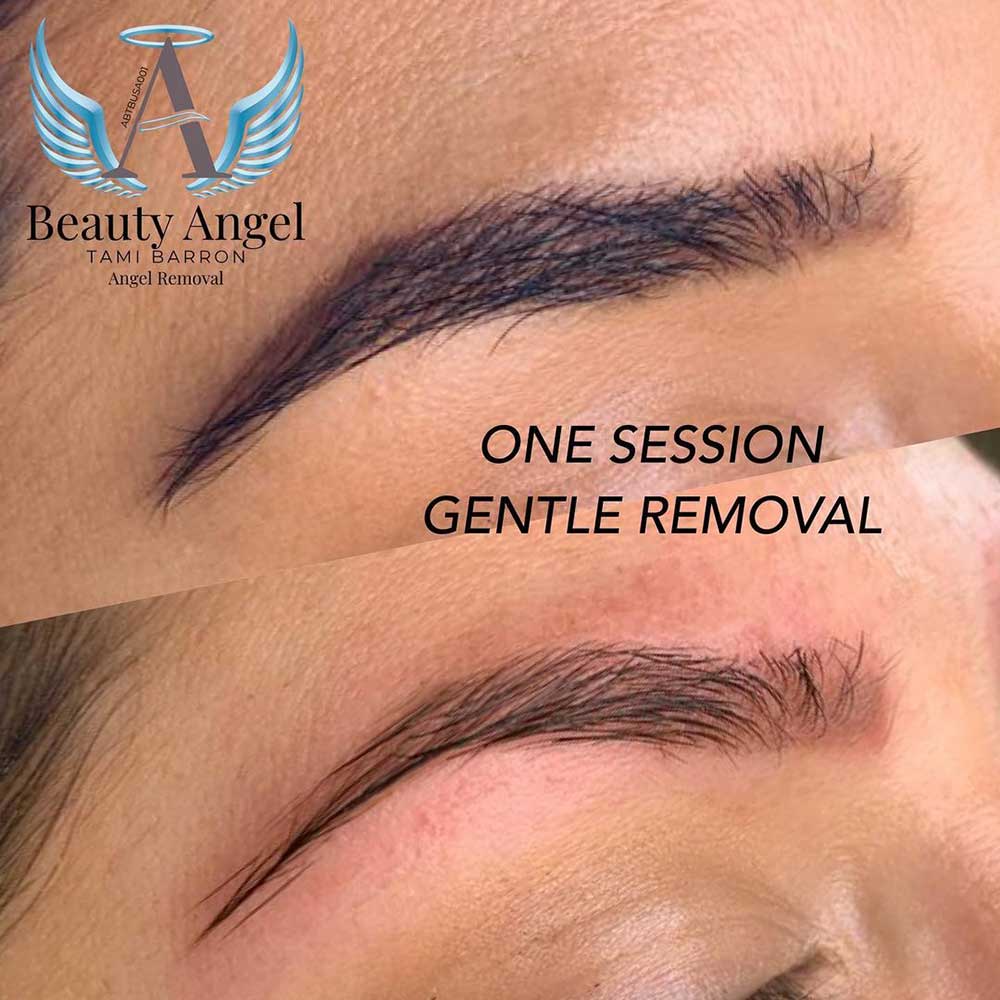
METHODS OF PERMANENT MAKEUP REMOVAL
What PMU Removal Methods Are There?
PMU removal has evolved through the years, and there are finally methods that really work. They emerged from traditional tattoo removal, but were adapted to PMU pigments and the areas treated – the face is a very delicate area, the skin is thinner than on other parts of the body, and it takes a special skill and expertise.
The most efficient permanent makeup removal methods are laser, saline, and glycolic acid removal.
There are a few cheaper and less aggressive methods, but these are less effective. They include topical chemical solution removal, which is yet to be proven as effective, and intense exfoliation through microdermabrasion, which can fade the results to a point, but not remove them.
Laser PMU Removal
ATTENTION: Laser permanent makeup removal can only be done on cosmetic tattoos which are at least 6 months old. Otherwise, the pigment intensity can cause the laser to damage the skin.
How Does It Work?
The technician traces the laser beam over the unwanted pigments. The beam penetrates the skin and targets the pigment molecules. The heat and the laser energy break down the molecules into even smaller particles, which white blood cells take away and the body extracts.
Is It Effective?
The laser is very effective in removing black and cool brown pigments, but doesn’t work so well with other colors. The tech needs to be very skilled and have a laser device which can work at proper wavelengths.
The issue with laser PMU removal is that it’s not possible to remove pigments which have a white base. The white pigment base is most commonly titanium dioxide, and it’s used in most lip pigments, as it gives the tattoo a brighter base to sit on, making the color much more intense. When the laser hits this component, a chemical reaction occurs that turns the titanium dioxide from white to its original state – dark grey.
From there, extra non-laser removal treatments are needed to help remove the grey pigment.
Depending on the amount of this component, the situation can thus be made worse.
How Many Sessions Will I Need?
The number of sessions varies depending on pigment saturation – how faded the pigment is, how deep it was implemented, what color it is, etc. Most clients need between 2 and 6 sessions, with significant fading after the 1st session.
But more complex cases might require more sessions than that, and even combining several removal methods for maximum results.
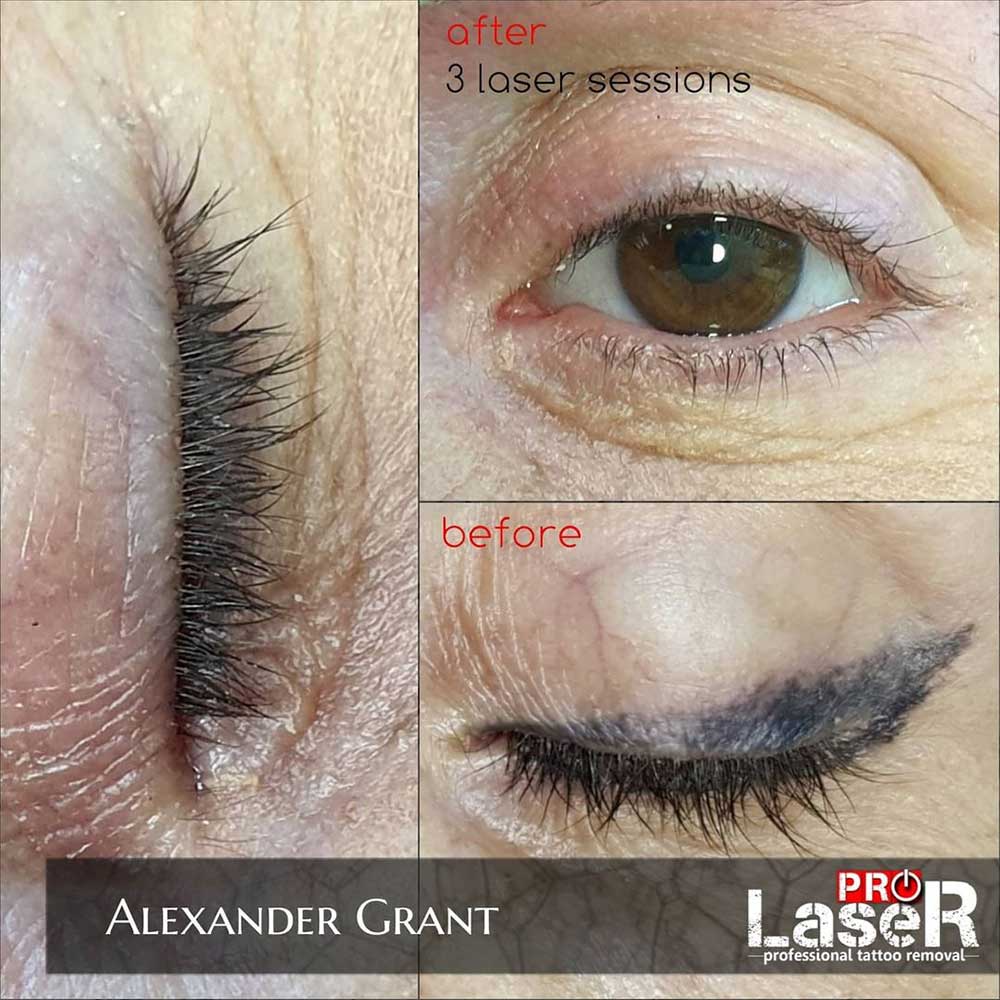
Is It Safe?
Laser removal is generally considered quite safe. It doesn’t cause a lot of trauma to the skin, and the chance of scarring is very low.
That said, not all laser devices are safe for darker skin – they can cause hypo- and hyperpigmentation – so it might take some research to find a technician who has proper equipment and experience.
Does It Hurt?
Before the treatment starts, a topical anesthetic is applied that numbs the area. This will significantly relieve the pain, but you will still feel some discomfort. Luckily, it’s all over in under 20 minutes.
There might be some pain afterwards, though, when the anesthetic wears off. Nothing a mild painkiller won’t solve, though.
What’s the Healing Like?
After a laser permanent makeup removal session, your skin needs 4-8 weeks to heal completely.
After the treatment, a scab will be formed over the treated area. It’s important you don’t touch or pick at the scab, because you can cause damage to the skin, and contaminate the wound. The removal tech will probably prescribe an ointment that will accelerate the healing.
How Much Does It Cost?
Laser PMU removal is charged per session, and the average price of a session is around $215. You can find treatments priced as low as $100, or as expensive as $500. The price depends on your location and the experience of the technician.
NOTE: Laser permanent makeup removal burns hairs! This could be a potential issue for eyebrow tattoo removal, but your brows will grow back out just fine within a couple of weeks.
Saline Removal
Is It Safe?
Laser removal is generally considered quite safe. It doesn’t cause a lot of trauma to the skin, and the chance of scarring is very low.
That said, not all laser devices are safe for darker skin – they can cause hypo- and hyperpigmentation – so it might take some research to find a technician who has proper equipment and experience.
Does It Hurt?
Before the treatment starts, a topical anesthetic is applied that numbs the area. This will significantly relieve the pain, but you will still feel some discomfort. Luckily, it’s all over in under 20 minutes.
There might be some pain afterwards, though, when the anesthetic wears off. Nothing a mild painkiller won’t solve, though.
What’s the Healing Like?
After a laser permanent makeup removal session, your skin needs 4-8 weeks to heal completely.
After the treatment, a scab will be formed over the treated area. It’s important you don’t touch or pick at the scab, because you can cause damage to the skin, and contaminate the wound. The removal tech will probably prescribe an ointment that will accelerate the healing.
How Much Does It Cost?
Laser PMU removal is charged per session, and the average price of a session is around $215. You can find treatments priced as low as $100, or as expensive as $500. The price depends on your location and the experience of the technician.
NOTE: Laser permanent makeup removal burns hairs! This could be a potential issue for eyebrow tattoo removal, but your brows will grow back out just fine within a couple of weeks.
It works for all pigment colors, and with some persistence, it can remove the unwanted cosmetic tattoo almost entirely.
How Many Sessions Will I Need?
The number of sessions depends on how concentrated the pigment is, and the desired effects.
For total removal, most clients need between 2 and 8 sessions. The first session will lighten the marks significantly, but a shadow will still be visible.
If you’re planning on getting a fresh cosmetic tattoo once the old one is removed, it may be enough to just lighten the old one and cover it up. In that case, 1 session may be enough.
Is It Safe?
If done right, saline removal is completely safe.
However, since the skin is broken, there’s a slight risk of scarring. If your removal tech is experienced and skilled, this shouldn’t be a problem, though.
Does It Hurt?
Just like it was the case with the initial pigmentation, saline removal uses a topical anesthetic to numb the area before the skin is broken. So there shouldn’t be any pain per se, but you may feel some pressure and a scratching-like sensation.
Since the treatment is done by reversing the initial implementation, you can expect the experience to be very similar to the tattooing or microblading.
What’s the Healing Like?
The saline removal healing process will be very similar to the healing period after you got your PMU tattoo. You’ll need to keep the area dry for a couple of days, and then apply a prescribed ointment.
You mustn’t touch or pick at the scabs; let them fall off on their own.
Depending on the area treated, the scabs will fall off within 10-14 days, but your skin needs 4-6 weeks to recover completely before you can book the next removal session.
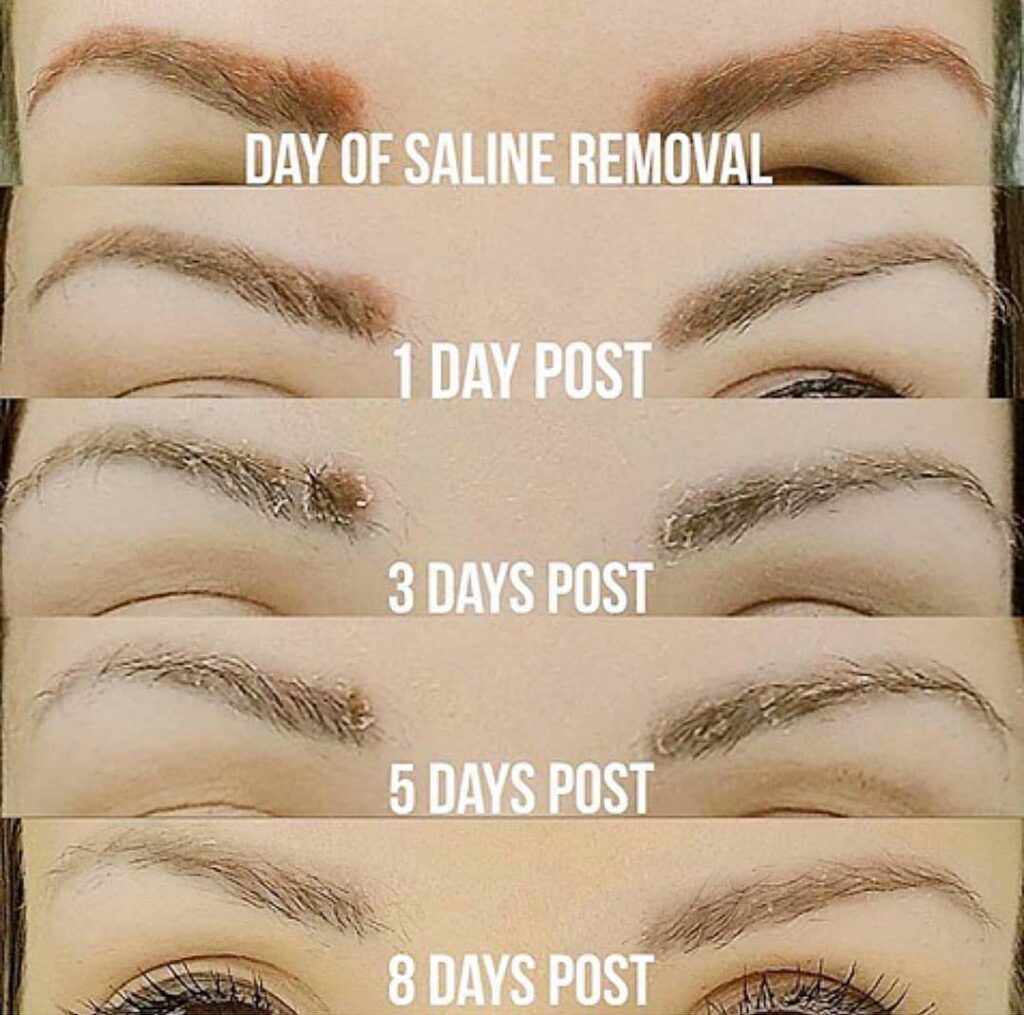
How Much Does It Cost?
Saline removal is usually charged per session. A single session is usually priced at around $250, but some tech charge as much as $500.
Some tech charge different prices for different types of PMU tattoos – lips tend to be more expensive.
Glycolic Acid Removal
A technique very similar to saline removal, the only difference is the removal solution formula.
How Does It Work?
Glycolic acid removal works just like saline removal.The removal tech uses a blade or a machine to open up the skin above the unwanted pigments, and injects a chemical solution made of glycolic and lactic acid into the cuts. The formula binds pigment particles to itself.Once the cuts made start to heal, a scab is formed. The pigments get lifted and stuck in the scab, and once the scab falls off, the pigment goes with it.
Is It Effective?
Yes, if done properly, glycolic acid removal can be 100% effective.It works for all pigment colors, and with some persistence, it can remove the unwanted cosmetic tattoo almost entirely.
How Many Sessions Will I Need?
The number of sessions depends on how concentrated the pigment is, how old the tattoo is, and the desired effects.For total removal, most clients need between 2 and 10 sessions. The first session will lighten the marks significantly, but a shadow will still be visible.If you’re planning on getting a fresh cosmetic tattoo once the old one is removed, it may be enough to just lighten the old one and cover it up. In that case, 1-2 sessions may be enough.
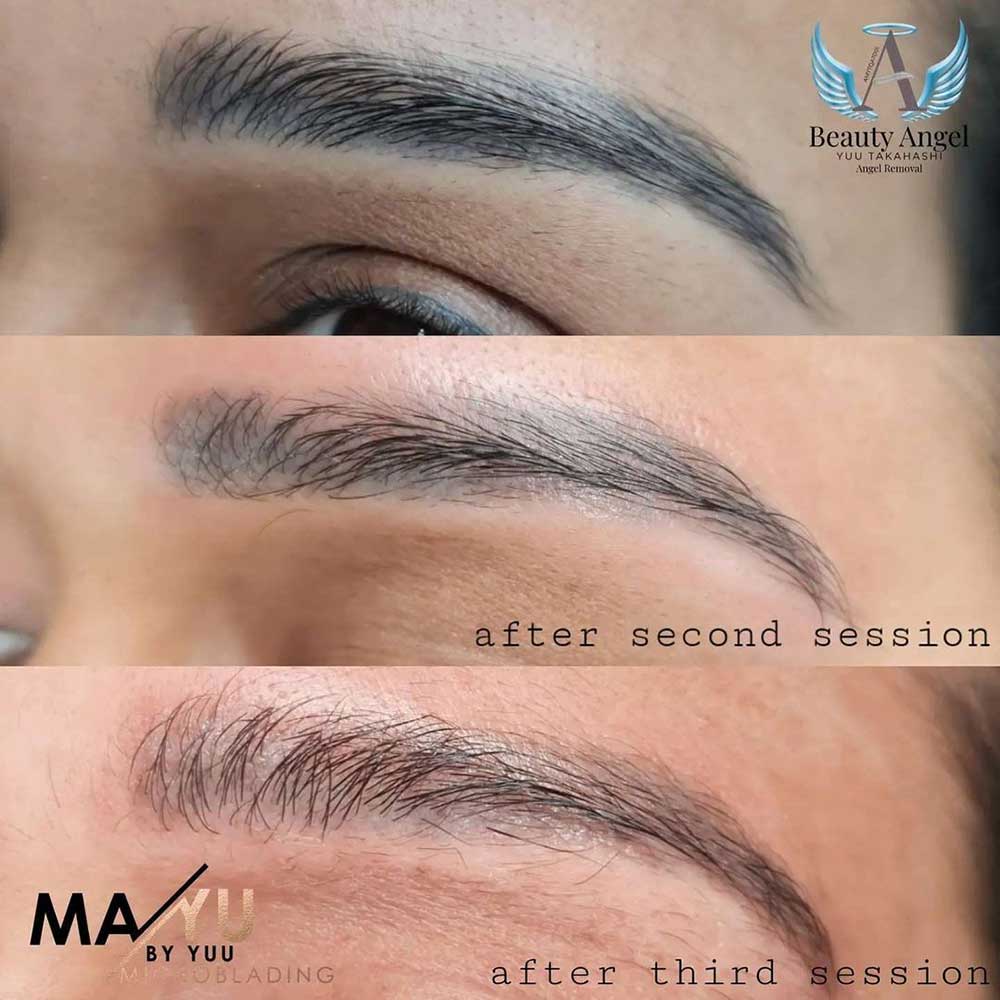
Is It Safe?
If done right, glycolic acid PMU removal is completely safe.
However, since the skin is broken, there’s a slight risk of scarring. If your removal tech is experienced and skilled, this shouldn’t be a problem, though.
Does It Hurt?
Just like it was the case with the initial pigmentation, glycolic acid PMU removal uses a topical anesthetic to numb the area before the skin is broken. So there shouldn’t be any pain per se, but you may feel some pressure and a scratching-like sensation.
Since the treatment is done by reversing the initial implementation, you can expect the experience to be very similar to tattooing or microblading.
What’s the Healing Like?
The glycolic acid removal healing process will be very similar to the healing period after you got your PMU tattoo. You’ll need to keep the area dry for a couple of days, and then apply a prescribed ointment.
You mustn’t touch or pick at the scabs; let them fall off on their own.
Depending on the area treated, the scabs will fall off within 10-14 days, but your skin needs 4-6 weeks to recover completely before you can book the next removal session.
How Much Does It Cost?
Glycolic acid removal is usually charged per session, and it’s a bit more expensive than laser and saline. A single session is usually priced at around $400, but some tech charge as much as $700.
Some tech charge different prices for different types of PMU tattoos – lips tend to be more expensive.
Emergency Permanent Makeup Removal
If you’re unsatisfied with the results of your PMU treatment right when you leave the salon and you’re 100% sure you don’t like them, you can get emergency saline removal.
It can be done within 48 hours after the treatment, before the skin starts closing up. It’s done by applying the saline solution directly onto the treated area – there’s no need to open up the skin again, as it still hasn’t closed up from the PMU treatment.
If you wait longer than 48 hours, though, this is no longer possible. You have to wait 4-6 weeks for the skin to heal completely. Otherwise, you risk permanent scarring.
Note: Having PMU tattoo removal during your menstrual cycle may increase your sensitivity.

How Do I Choose the Best Removal Tech?
Finding the right PMU removal tech can be tricky, especially if you live in a smaller town or an area with few options.
But trusting the wrong person can lead to detrimental consequences – infections, scarring, unsatisfactory results, etc.
Therefore, you should do some research and find a certified, experienced tech, and go through their portfolio. Never go to an uncertified, self-taught tech – they can put your health in danger.
The price of permanent makeup removal varies from one tech to another, and a higher cost usually means more experience. Of course, you can also find cost-friendly treatments, but don’t let price be the only factor – always research the tech, read through their reviews, and explore their previous work.
PERMANENT MAKEUP REMOVAL SIDE-EFFECTS & RISKS
Are There Any Risks to Permanent Makeup Removal?
- Scarring. The biggest risk to permanent makeup removal is scarring. If the removal tech isn’t very careful, they may cause excessive trauma to the skin that will result in permanent scarring. The risk of this is higher with saline and glycolic acid PMU removal as those imply opening up the skin with an instrument, but the wrong laser wavelength can also cause it.
- Infection. If the treatment isn’t performed according to all hygiene and safety standards, the area treated can get infected. Most infections are mild, but more severe cases can happen, and in any case, it’s best to prevent this altogether – never go to an uncertified, self-taught tech!
- Allergies. The chemicals used for saline and glycolic acid removal may cause allergies. The tech should always do a patch test beforehand to make sure you’re not allergic to any of the products used.
PERMANENT MAKEUP REMOVAL HEALING AND AFTERCARE
After each PMU removal session, you have to pay some special attention to the treated area so it heals properly. The surface healing process lasts for about 14 days, with minor deviations depending on the area treated, while internal healing takes up to 6 weeks.
Let’s take a look at the universal do’s and don’ts of permanent makeup removal aftercare regardless of the method.
What’s the Aftercare Process for Permanent Makeup Removal?
- Keep the area dry at least two days after the procedure. Clean as instructed by your removal tech.
- After 2 days, start applying a prescribed aftercare ointment as instructed by your tech. Keep this up until the scabs fall off, or longer if advised.
- Do whatever you can to prevent contamination – never touch the area and make sure it doesn’t come into contact with any unsterile surface.
What Should I Avoid During Permanent Makeup Removal Healing?
- Don’t apply anything other than the prescribed ointment onto the area for 10 – 14 days. No makeup, no skincare.
- Don’t touch the scabs. Let them fall off naturally. Try to sleep on your back if possible.
- Don’t expose the treated area to sunlight for at least 2 weeks after the treatment. The same goes for tanning beds.
- Don’t get the area soaking wet – refrain from intense exercise, swimming, going to saunas or steam baths.
- Don’t get any facials or beauty treatments in or around the treated area.
REASONS FOR PERMANENT MAKEUP REMOVAL
Should I Get Permanent Makeup Removal?
Sometimes, PMU just doesn’t work out and you don’t like it, or you simply grow tired of it after a few a while. Other times, the fading process isn’t going according to plan, or the pigments migrated outside of the initial outline. Some clients come in for removal with outdated tattoos done with permanent inks.
The most common reasons why people decide to get permanent makeup removal are:
You don’t like how it turned out.
You don’t like it anymore after some time.
It’s not fading properly – the pigments may have been implemented too deep, and you’re stuck with an unattractive vague shadow rather than a makeup look.
Pigments migrated, making the cosmetic tattoo look smudged and messy.
All these are valid reasons for seeking permanent makeup removal, but committing to the removal process takes time, patience, and money.
None of the methods can give satisfactory results within 1 session. You need to get multiple sessions, spaced at least 4-6 weeks apart, and go through the healing process and aftercare routine after each one.
PMUHub Tip: As you can see, permanent makeup removal is a process. This is why we advise you to think this decision through carefully – is it possible for you to just wait out until the pigments fade on their own?
Of course, if they’re not fading the way they’re supposed to, you have no choice, but if the sole reason you’re considering removal is because you don’t like it anymore, maybe you can spare yourself the hassle and just cover it up with regular makeup until it fades, and accelerate the fading with exfoliation and skincare products.
EYEBROW TATTOO REMOVAL
Should I Get Permanent Makeup Removal?
All 3 permanent makeup removal methods work for eyebrow tattoos, and they work more or less equally well, with the exception of laser’s inability to remove reddish and yellow pigments. If your brows are reddish, laser removal can be combined with saline or glycolic acid removal.
Eyebrow tattoos can be removed regardless of style:
- For more information on microblading removal, read this article.
- For more information on powder brows removal, read this article.
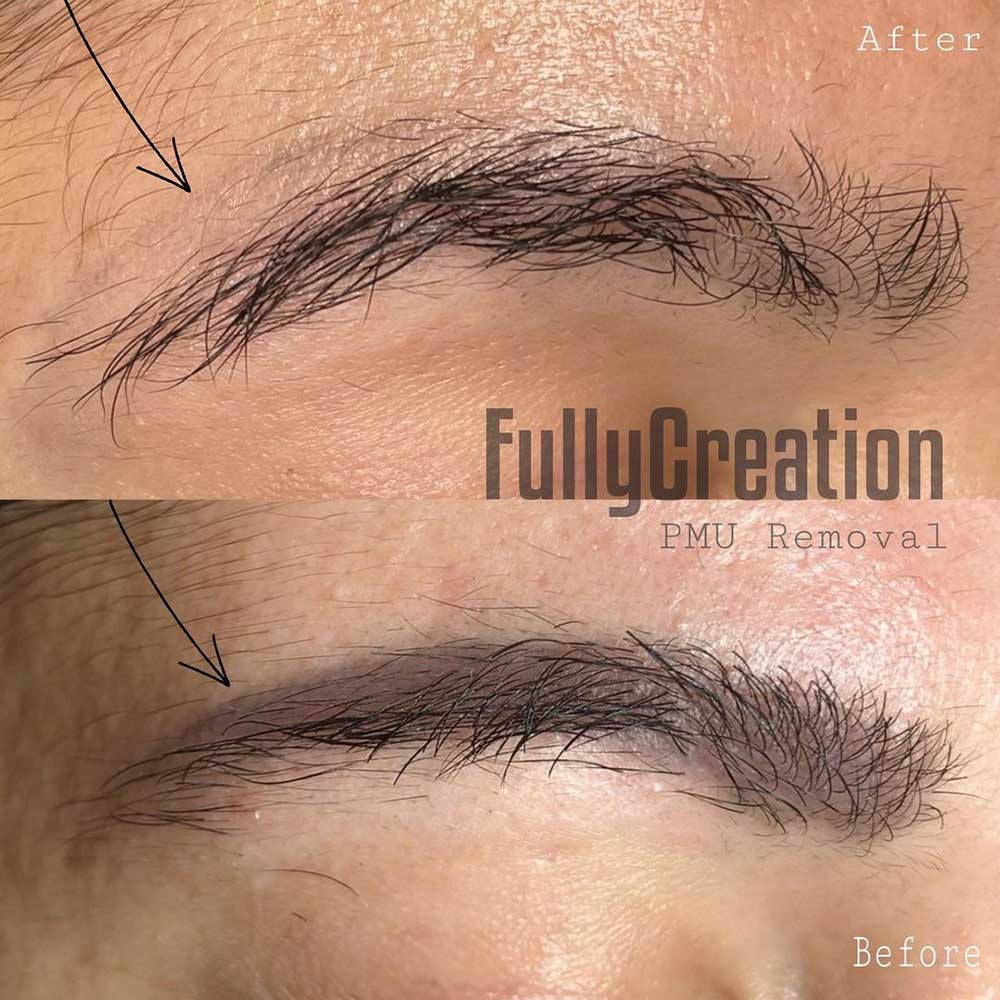
EYELINER TATTOO REMOVAL
How Can PMU Eyeliner Be Removed?
Eyeliner tattoo removal has its own set of challenges, and very few removal techs offer this service.
Laser Eyeliner Tattoo Removal
Laser eyeliner tattoo removal can be very risky, and it takes a lot of experience to master, plus special equipment that’s safe for treating the eye area. So not all laser removal techs work on the eyelids.
The treatment requires inserting metal plates that resemble contact lenses into your eyes that protect the cornea from damage. Since eyelids are very sensitive and their skin is very thin, the treatment can be quite uncomfortable regardless of the numbing. Swelling and bruising are very common side-effects – nothing serious, but it is annoying.
Saline and Glycolic Acid Eyeliner Tattoo Removal
Non-laser eyeliner PMU removal are perhaps better options, but again, not many removal techs offer this service. It takes a very meticulous technique to avoid permanent scarring, and only the most experienced PMU removal techs dare to do it. Finding one might be a challenge.
For more information on permanent eyeliner removal, read this article.
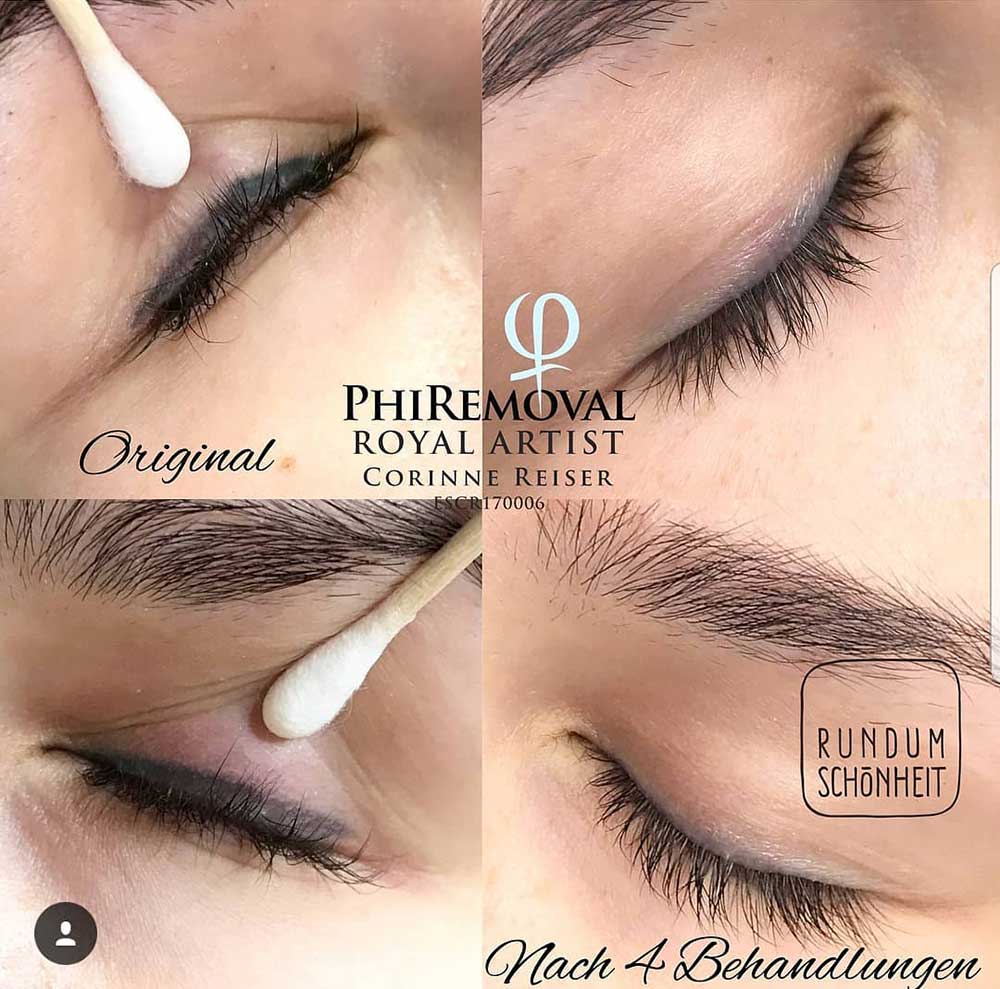
LIP TATTOO REMOVAL
How Can Lip Tattoos Be Removed?
The issue with lip tattoo removal is that lasers are often not an option. The reddish and pink pigments used for lip tattoos almost always contain titanium dioxide, so the laser can make them turn grey.
So saline and glycolic acid lip tattoo removal are better options.
If the unwanted pigments are outside of the vermilion border – on the skin around the lips rather than the lips themselves – the lip liner tattoo can be removed quite successfully and without any particular challenges.
But if you want to get rid of full lip color or lip blush, you might have a hard time finding a permanent makeup removal tech who’s willing to do the treatment.
The good news is that unwanted lip blush can be camouflaged as easily as a swipe of lipstick. Unless you’re dealing with a clown-like misplaced lip liner, you truly don’t have to go through the hassle of removal, you can just cover it up and wait out until it fades.
You can fade the pigments significantly with frequent exfoliation.
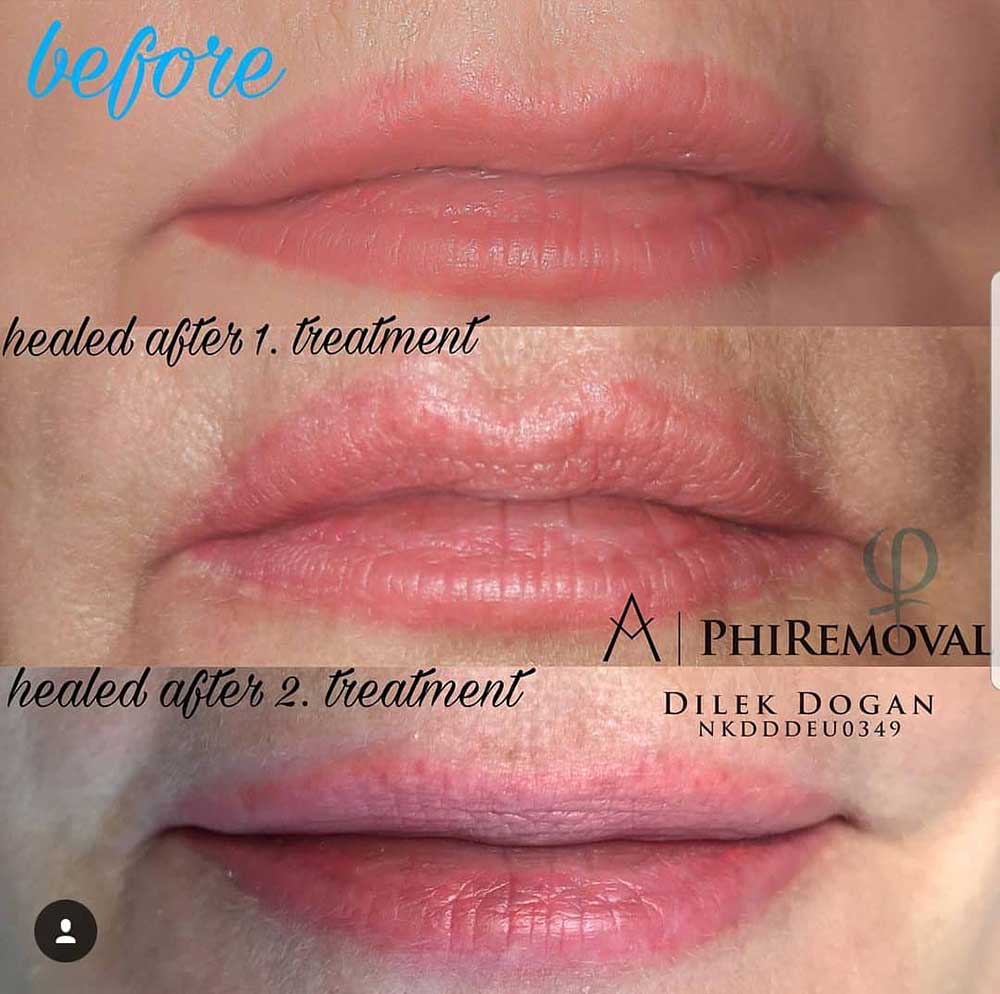
SCALP MICROPIGMENTATION REMOVAL
How Does Scalp Micropigmentation Removal Work?
Laser is the only option for scalp micropigmentation removal, and it can work quite successfully. The only problem is the fact that laser burns hairs, but since most SMP clients don’t have long hair, this shouldn’t be a deal-breaker.
Bear in mind, though, that laser removal is risky for dark-skinned clients. They are at greater risk of hypopigmentation or hyperpigmentation (skin lightening or skin darkening).
Saline and glycolic acid could technically be possible, but the area is simply too large to be treated this way.
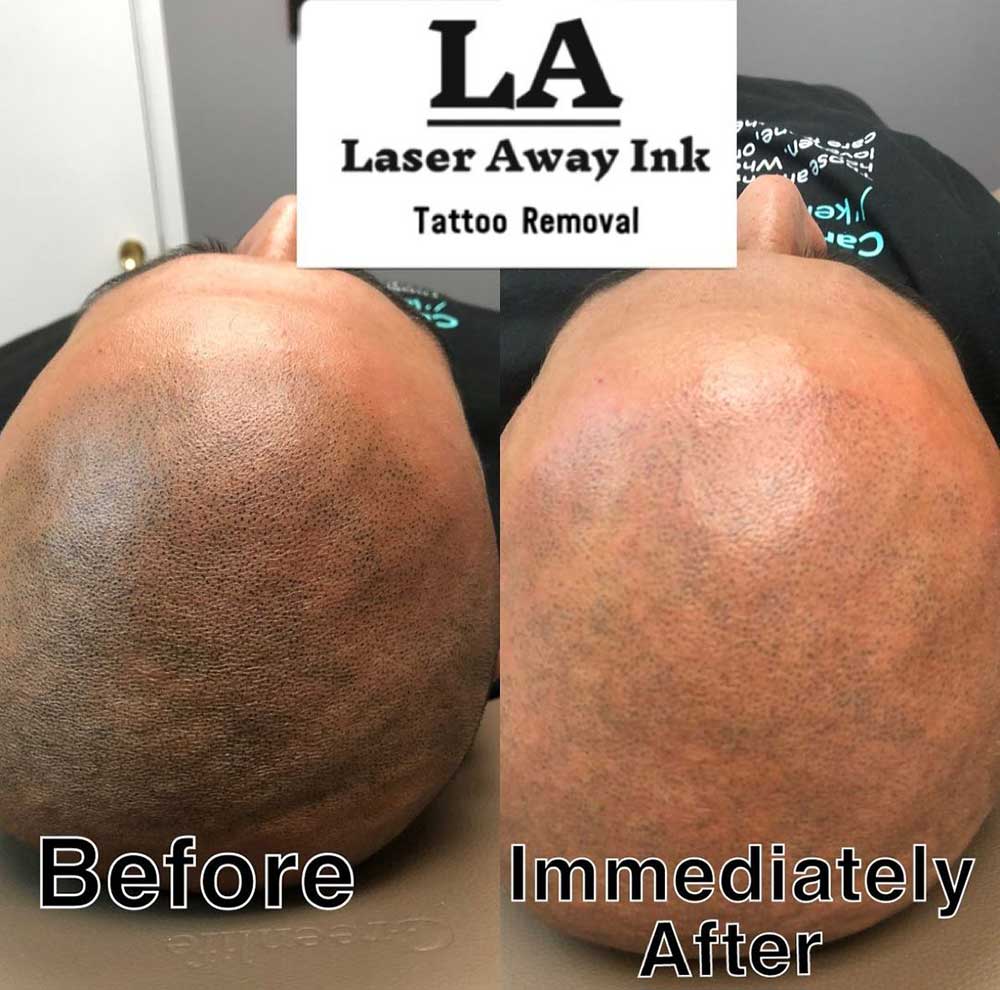
PERMANENT MAKEUP REMOVAL COST
How Much Does Permanent Makeup Removal Cost?
All 3 methods of permanent makeup removal are charged per session, with many salons offering package deals.
The price per session is very similar for laser and saline – around $250, but it can range from $100 to $500, depending on many factors, such as location and the experience of the artist.
Glycolic acid removal is somewhat more expensive, with the average price per session being $440.
PERMANENT MAKEUP REMOVAL – MAIN TAKEAWAYS
Permanent makeup removal is definitely possible, but it takes 2+ sessions spaced out at least 4-6 weeks apart. So it can drag out for months. The most efficient PMU removal methods are laser, saline, and glycolic acid removal, and they sometimes need to be combined for maximum effects.
The price of a permanent makeup removal session is anywhere from $100 to $700, so it’s not a small investment. Nevertheless, if you feel like your cosmetic tattoo is a source of insecurity and prevents you from living your life to the fullest, it’s worth it.
Just make sure you find a PMU removal tech who has experience treating your particular area – not all of them are willing to work on eyelids and lips.
weekly insight into PMU insdustry
Subscribe to our FREE newsletter. 100% good stuff.

support us so we can keep providing you with free education , information and inspiration.
